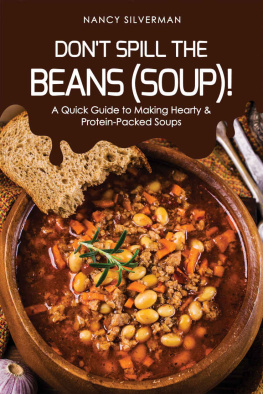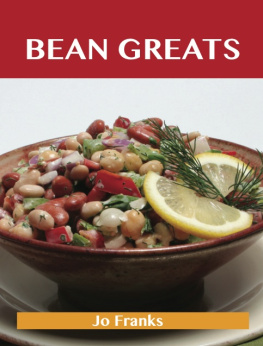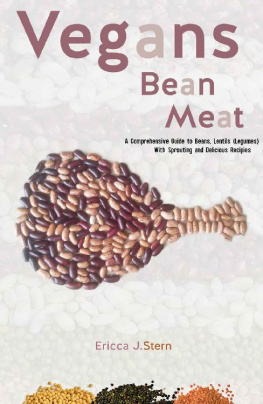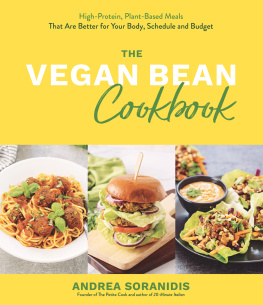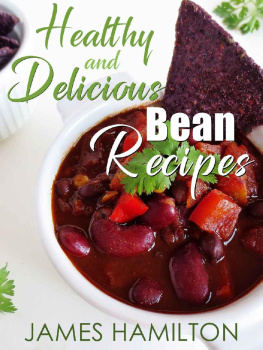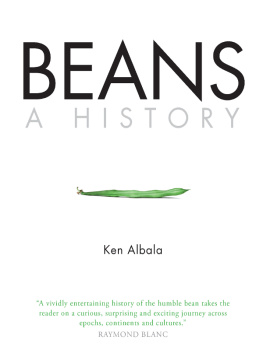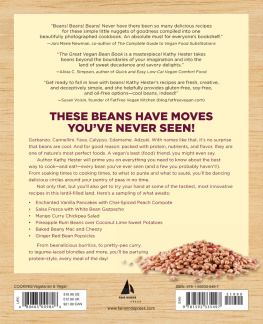
Adventurous Recipes
for the Most Delicious, Nutritious
and Flavorful Bean Dishes Ever
KELSEY KINSER

Ulysses Press
Text Copyright 2014 Kelsey Kinser. Design and concept copyright 2014 Ulysses Press and its licensors. All rights reserved. Any unauthorized duplication in whole or in part or dissemination of this edition by any means (including but not limited to photocopying, electronic devices, digital versions, and the Internet) will be prosecuted to the fullest extent of the law.
Published by
Ulysses Press
P.O. Box 3440
Berkeley, CA 94703
www.ulyssespress.com
ISBN: 978-1-61243-347-9
Library of Congress Catalog Number 2013957410
10 9 8 7 6 5 4 3 2 1
Acquisitions editor: Keith Riegert
Managing editor: Claire Chun
Project editor: Alice Riegert
Editor: Beverly McGuire
Proofreader: Barbara Schultz
Front cover design: Rebecca Lown
Interior layout and design: what!design @ whatweb.com
Cover photograph: Madlen/shutterstock.com
Index: Sayre Van Young
Distributed by Publishers Group West
IMPORTANT NOTE TO READERS: This book is independently authored and published and no sponsorship or endorsement of this book by, and no affiliation with, any trademarked brands or other products mentioned within is claimed or suggested. All trademarks that appear in this book belong to their respective owners and are used here for informational purposes only. The author and publisher encourage readers to patronize the quality brands and products mentioned in this book.
This book is dedicated to New York City,
the most delicious place in the world.
Table of Contents

Every dish in this book is good food, not just good vegan food. This was the first deciding factor in whether or not a recipe made it into this publication. Personally, I am not a full-time vegan, though I do tend to prefer vegan foods for the way that they make me feel, both physically and morally.
Second, I wanted the book to be a nice mixture of classics and new-styled recipes that Ive experienced during my travels around the globe. Ive lived in Spain, France, Jamaica, and Greece and have traveled to many other lands. Currently, I call New York City home, and I work professionally as a pastry chef. Its true that New York is the melting pot of the world, and any exotic herb or spice would certainly be a short subway ride away for me. However, I have made sure that these recipes are accessible for those who dont live in New York, or India, or Mexico, or any of the lands from which some of these meals hail.
Because most of us are not spending our day-to-day lives traveling the world, we can instead indulge our wanderlust through cooking. Making a pot of cassoulet will whisk you away to the French Pyrenees; bean burritos will make you long for the surf crashing on the California coast; and, because most of these recipes are relatively light, after eating them you might feel like you actually would still have the energy to explore all these distant lands! Besides that, most of these recipes are rather inexpensive to make, which allows you to set aside more money if traveling is your ultimate goal. Even if its not, saving money is always nice, and if you disagree, there are plenty of expensive heirloom beans that you can buy to be extravagant.
Writing this book has been a tremendous amount of fun for me. It has been a trip full of nostalgia, excitement, and learning. Making the gigandes instantly brought me back to my time spent in Greece, while making the crunchy green beans taught me a new (and now new favorite) snack food idea.
I have an entirely new appreciation for the almighty (yet still humble) legume. Inexpensive, healthy, delicious, and appreciated the whole world over, beans are a universal language. What more can you ask for?
Why Beans Are Important to the Vegan Diet
Beans are an important part of the diet of anyone, not just vegans and vegetarians. Beans can be found all over the world, in high-end specialty stores or in corner markets. They are a wonderful package of protein, vitamins, minerals, and flavor, all packed into an affordable and neat little bundle. When paired with rice, they form a complete protein that is very important for any person living on a vegetarian diet. The human body requires 21 amino acids, and the body itself creates 12 of those acids, but it needs to find the other 9 in food. A complete protein is a protein that contains all 9 of these acids. The most common forms of complete protein are meat and eggs, but other great examples of complete proteins are hemp seeds, buckwheat, and, of course, rice paired with beans. Beyond having protein, beans on their own are fat- and cholesterol-free and are full of fiber, potassium, folate, iron, manganese, and magnesium.
Dried Beans Versus Canned Beans
Most of the recipes in this book call for dried beans that have been soaked and then cooked. You can use canned beans for any of these recipes if that is your preference. Here are some guidelines when it comes to substituting the proper amount of canned cooked beans for raw dried beans and more. Recipes that call for dried beans also will have steps that are meant to cook the beans: usually the first step, and usually involving simmering for around 45 to 90 minutes. You will have to take this into account and skip these steps if using canned beans.
1 pound dry beans = 2 cups = average 6 cups cooked
1 cup dried beans = 2 to 3 cups cooked
1 (16-ounce) can beans = 2 cups with liquid, 1-1/2 cups drained
Prepping Your Beans for Soaking and Cooking
It is this authors opinion that soaked dried beans are usually superior to canned beans. The main exception to this would be chickpeas (also known as garbanzos), which seem to be more consistent when canned without compromising on flavor. Soaking beans is one of the easiest culinary tasks imaginable, and all it requires is a little bit of forethought. Although you might groan at the idea of having to plan for tomorrows dinner tonight, have faith because there are a plethora of reasons to soak your beans. There are a few different methods of soaking beans. You can use the long (also known as cold or overnight) soak, which requires the least amount of effort, the quick (or hot) soaking method, or the pressure cooker method. Each way has its pros and cons, and whichever manner of soaking you choose will still require a quick check and rinse of your beans. Dried beans arent exactly clean. Were not trying to build up an immunity to dust and dirt; were just trying to make tasty, healthy, animal-free cuisine, so lets sort and rinse these beans first. Spread the beans out on a cookie pan and scan through them to make sure there are no off-colored or pest-nibbled beans, small pebbles, or rocks among your dried little jewels. After sorting through the beans, place them in a small-holed colander (so as not to lose your beans) and rinse them well under cold water. They are now ready for your soaking method of choice.
Dried Bean Pros
Do you prefer your beans firmer or on the softer side? Soaking and cooking your own dried beans allow you greater control of the end product.

 Dried beans are less costly than canned beans.
Dried beans are less costly than canned beans.
Next page

